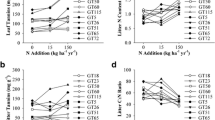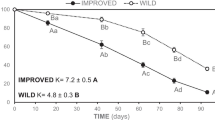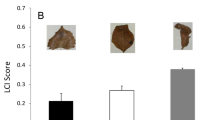Abstract
In addition to potential benefits, biotechnology in silviculture may also be associated with environmental considerations, including effects on organisms associated with the living tree and on ecosystems and processes dependent on tree residue. We examined whether genetic modification of lignin characteristics (CAD and COMT) in Populus sp. affected leaf litter quality, the decomposition of leaf litter, and the assemblages of aquatic insects colonizing the litter in three natural streams. The decomposition of leaf litter from one of the genetically modified (GM) lines (CAD) was affected in ways that were comparable over streams and harvest dates. After 84 days in streams, CAD-litter had lost approximately 6.1% less mass than the non-GM litter. Genetic modification also affected the concentration of phenolics and carbon in the litter but this only partially explained the decomposition differences, suggesting that other factors were also involved. Insect community analyses comparing GM and non-GM litter showed no significant differences, and the two GM litters showed differences only in the 84-day litterbags. The total abundance and species richness of insects were also similar on GM and non-GM litter. The results presented here suggest that genetic modifications in trees can influence litter quality and thus have a potential to generate effects that can cross ecosystem boundaries and influence ecosystem processes not directly associated with the tree. Overall, the realized ecological effects of the GM tree varieties used here were nevertheless shown to be relatively small.


Similar content being viewed by others
References
Adler E. 1977. Lignin chemistry—past, present and future. Wood Sci Technol 11:169–218.
Aerts R. 1997. Climate, leaf litter chemistry and leaf litter decomposition in terrestrial ecosystems: a triangular relationship. Oikos 79:439–49.
Anderson MJ. 2001. A new method for non-parametric multivariate analysis of variance. Austral Ecol 26:32–46.
Baucher M, Chabbert B, Pilate G, VanDoorsselaere J, Tollier MT, PetitConil M, Cornu D, Monties B, VanMontagu M, Inze D, Jouanin L, Boerjan W. 1996. Red xylem and higher lignin extractability by down-regulating a cinnamyl alcohol dehydrogenase in poplar. Plant Physiol 112:1479–90.
Brodeur-Campbell SE, Vucetich JA, Richter DL, Waite TA, Rosemier JN, Tsai CJ. 2006. Insect herbivory on low-lignin transgenic aspen. Environ Entomol 35:1696–701.
Clarke KR. 1993. Non-parametric multivariate analyses of changes in community structure. Aust J Ecol 18:117–43.
Clarke KR, Gorley RN. 2001. Primer v5: user manual/tutorial. Plymouth: Primer-E Ltd.
Cummins KW, Klug MJ. 1979. Feeding ecology of stream invertebrates. Annu Rev Ecol Syst 10:147–72.
Cummins KW, Wilzbach MA, Gates DM, Perry JB, Taliferro WB. 1989. Shredders and riparian vegetation. Bioscience 39:24–30.
Dixon RA, Achnine L, Kota P, Liu CJ, Reddy MSS, Wang LJ. 2002. The phenylpropanoid pathway and plant defence—a genomics perspective. Mol Plant Pathol 3:371–90.
Driebe EM, Whitham TG. 2000. Cottonwood hybridization affects tannin and nitrogen content of leaf litter and alters decomposition. Oecologia 123:99–107.
Field JG, Clarke KR, Warwick RM. 1982. A practical strategy for analyzing multispecies distribution patterns. Mar Ecol Prog Ser 8:37–52.
Findlay S, Carreiro M, Krischik V, Jones CG. 1996. Effects of damage to living plants on leaf litter quality. Ecol Appl 6:269–75.
Giller PS, Malmqvist B. 1998. The biology of streams and rivers. Oxford: Oxford University Press.
Griffiths NA, Tank JL, Royer TV, Rosi-Marshall EJ, Whiles MR, Chambers CP, Frauendorf TC, Evans-White MA. 2009. Rapid decomposition of maize detritus in agricultural headwater streams. Ecol Appl 19:133–42.
Haapala A, Muotka T, Markkola A. 2001. Breakdown and macroinvertebrate and fungal colonization of alder, birch, and willow leaves in a boreal forest stream. J N Am Benthol Soc 20:395–407.
Halpin C, Thain SC, Tilston EL, Guiney E, Lapierre C, Hopkins DW. 2007. Ecological impacts of trees with modified lignin. Tree Genet Genomes 3:101–10.
Hattenschwiler S, Tiunov AV, Scheu S. 2005. Biodiversity and litter decomposition interrestrial ecosystems. Annu Rev Ecol Evol Syst 36:191–218.
Hjältén J, Lindau A, Wennström A, Blomberg P, Witzell J, Hurry V, Ericson L. 2007. Unintentional changes of defence traits in GM trees can influence plant–herbivore interactions. Basic Appl Ecol 8:434–43.
Hoenicka H, Fladung M. 2006. Biosafety in Populus spp and other forest trees: from non-native species to taxa derived from traditional breeding and genetic engineering. Trees Struct Funct 20:131–44.
Julkunen-Tiitto R, Sorsa S. 2001. Testing the effects of drying methods on willow flavonoids, tannins, and salicylates. J Chem Ecol 27:779–89.
Kominoski JS, Pringle CM, Ball BA, Bradford MA, Coleman DC, Hall DB, Hunter MD. 2007. Nonadditive effects of leaf litter species diversity on breakdown dynamics in a detritus-based stream. Ecology 88:1167–76.
Lapierre C, Pollet B, Petit-Conil M, Toval G, Romero J, Pilate G, Leple JC, Boerjan W, Ferret V, De Nadai V, Jouanin L. 1999. Structural alterations of lignins in transgenic poplars with depressed cinnamyl alcohol dehydrogenase or caffeic acid O-methyltransferase activity have an opposite impact on the efficiency of industrial kraft pulping. Plant Physiol 119:153–63.
Lecerf A, Chauvet E. 2008. Intraspecific variability in leaf traits strongly affects alder leaf decomposition in a stream. Basic Appl Ecol 9:598–605.
Lecerf A, Risnoveanu G, Popescu C, Gessner MO, Chauvet E. 2007. Decomposition of diverse litter mixtures in streams. Ecology 88:219–27.
LeRoy CJ, Marks JC. 2006. Litter quality, stream characteristics and litter diversity influence decomposition rates and macroinvertebrates. Freshw Biol 51:605–17.
LeRoy CJ, Whitham TG, Keim P, Marks JC. 2006. Plant genes link forests and streams. Ecology 87:255–61.
LeRoy CJ, Whitham TG, Wooley SC, Marks JC. 2007. Within-species variation in foliar chemistry influences leaf litter decomposition in a Utah river. J N Am Benthol Soc 26:426–38.
Lewis NG, Yamamoto E. 1990. Lignin—occurence, biogenesis and biodegradation. Annu Rev Plant Physiol Plant Mol Biol 41:455–96.
Madritch M, Donaldson JR, Lindroth RL. 2006. Genetic identity of Populus tremuloides litter influences decomposition and nutrient release in a mixed forest stand. Ecosystems 9:528–37.
Mathews JH, Campbell MM. 2000. The advantages and disadvantages of the application of genetic engineering to forest trees: a discussion. Forestry 73:371–80.
McArdle BH, Anderson MJ. 2001. Fitting multivariate models to community data: a comment on distance-based redundancy analysis. Ecology 82:290–7.
Melillo JM, Aber JF, Muratore JF. 1982. Nitrogen and lignin control of hardwood leaf litter decomposition dynamics. Ecology 63:621–6.
Mulder C, Lotz LAP. 2009. Biotechnology, environmental forcing, and unintended trophic cascades. Arthropod Plant Interact 3:131–9.
Ostrofsky ML. 1997. Relationship between chemical characteristics of autumn-shed leaves and aquatic processing rates. J N Am Benthol Soc 16:750–9.
Peters DJ, Constabel CP. 2002. Molecular analysis of herbivore-induced condensed tannin synthesis: cloning and expression of dihydroflavonol reductase from trembling aspen (Populus tremuloides). Plant J 32:701–12.
Pilate G, Guiney E, Holt K, Petit-Conil M, Lapierre C, Leple JC, Pollet B, Mila I, Webster EA, Marstorp HG, Hopkins DW, Jouanin L, Boerjan W, Schuch W, Cornu D, Halpin C. 2002. Field and pulping performances of transgenic trees with altered lignification. Nat Biotechnol 20:607–12.
Rosi-Marshall EJ, Tank JL, Royer TV, Whiles MR, Evans-White M, Chambers C, Griffiths NA, Pokelsek J, Stephen ML. 2007. Toxins in transgenic crop byproducts may affect headwater stream ecosystems. Proc Natl Acad Sci USA 104:16204–8.
Schweitzer JA, Bailey JK, Rehill BJ, Martinsen GD, Hart SC, Lindroth RL, Keim P, Whitham TG. 2004. Genetically based trait in a dominant tree affects ecosystem processes. Ecol Lett 7:127–34.
Snow AA, Andow DA, Gepts P, Hallerman EM, Power A, Tiedje JM, Wolfenbarger LL. 2005. Genetically engineered organisms and the environment: current status and recommendations. Ecol Appl 15:377–404.
Swan CM, Palmer MA. 2004. Leaf diversity alters litter breakdown in a Piedmont stream. J N Am Benthol Soc 23:15–28.
Tilston EL, Halpin C, Hopkins DW. 2004. Genetic modifications to lignin biosynthesis in field-grown poplar trees have inconsistent effects on the rate of woody trunk decomposition. Soil Biol Biochem 36:1903–6.
van Frankenhuyzen KU, Beardmore T. 2004. Current status and environmental impact of transgenic forest trees. Can J For Res 34:1163–80.
Vannote RL, Minshall GW, Cummins KW, Sedell JR, Cushing CE. 1980. The river continuum concept. Can J Fish Aquat Sci 37:130–7.
Wallace JB, Eggert SL, Meyer JL, Webster JR. 1997. Multiple trophic levels of a forest stream linked to terrestrial litter inputs. Science 277:102–4.
Wang J, Ives NE, Lechowicz MJ. 1992. The relation of foliar phenology to xylem embolism in trees. Funct Ecol 6:469–75.
Waterman PG, Mole S. 1994. Analysis of phenolic plant metabolites. Oxford: Blackwell Scientific Publications.
Yoshinaga A, Fujita M, Saiki H. 1997. Cellular distribution of guaiacyl and syringyl lignins within an annual ring in oak wood. J Jpn Wood Res Soc 43:384–90.
Acknowledgement
This study was supported by FORMAS (grant to J. Hjältén). We are also grateful of Magnus Lindberg for skilled insect identification and of two anonymous reviewers for insightful comments on a previous version of the manuscript.
Author information
Authors and Affiliations
Corresponding author
Additional information
Author Contributions
PA, JH, AW and CL designed the study. PA, JH performed the research and analyzed the data. RJT performed chemical analyses and GP provided the plant material. All authors contributed significantly to the interpretation of the data and writing of the paper.
Rights and permissions
About this article
Cite this article
Axelsson, E.P., Hjältén, J., LeRoy, C.J. et al. Can Leaf Litter from Genetically Modified Trees Affect Aquatic Ecosystems?. Ecosystems 13, 1049–1059 (2010). https://doi.org/10.1007/s10021-010-9373-y
Received:
Accepted:
Published:
Issue Date:
DOI: https://doi.org/10.1007/s10021-010-9373-y




